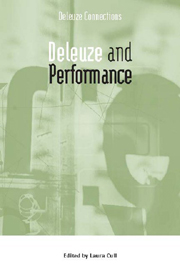Book contents
- Frontmatter
- Contents
- Introduction
- 1 Performing in the Chaosmos: Farts, Follicles, Mathematics and Delirium in Deleuze
- Act I Deleuze on Theatre: Artaud, Beckett and Carmelo Bene
- Interval
- Act II Confronting Deleuze and Live Performance
- Interval
- Act III A Digital Deleuze: Performance and New Media
- 11 Like a Prosthesis: Critical Performance à Digital Deleuze
- 12 Performance as the Distribution of Life: From Aeschylus to Chekhov to VJing via Deleuze and Guattari
- 13 The ‘Minor’ Arithmetic of Rhythm: Imagining Digital Technologies for Dance
- Notes on Contributors
- Index
13 - The ‘Minor’ Arithmetic of Rhythm: Imagining Digital Technologies for Dance
from Act III A Digital Deleuze: Performance and New Media
Published online by Cambridge University Press: 12 September 2012
- Frontmatter
- Contents
- Introduction
- 1 Performing in the Chaosmos: Farts, Follicles, Mathematics and Delirium in Deleuze
- Act I Deleuze on Theatre: Artaud, Beckett and Carmelo Bene
- Interval
- Act II Confronting Deleuze and Live Performance
- Interval
- Act III A Digital Deleuze: Performance and New Media
- 11 Like a Prosthesis: Critical Performance à Digital Deleuze
- 12 Performance as the Distribution of Life: From Aeschylus to Chekhov to VJing via Deleuze and Guattari
- 13 The ‘Minor’ Arithmetic of Rhythm: Imagining Digital Technologies for Dance
- Notes on Contributors
- Index
Summary
Expressivity
In 1968, in his book Changes: Notes on Choreography, Merce Cunningham imagined a future digital technology that would allow the composition of a choreography through the representation of 3D figures on a computer screen. Ever since his first creations, Cunningham's choreographic method has always implied an exploration of movement in itself, considering it as a non-conscious, non-intentional and random process; in this sense, his use of the Life Forms (and, later, the Dance Forms) software has brought about an expansion of his analytical and creative procedures. Everything can be decided simply by chance: the selection of body parts, their number and type of movement. After taking the choreographic process on a totally de-humanised compositional plane, beyond narratives, feelings and phenomenological connotations, what kind of expressive potential is left to the technologically choreographed dancing body?
Choreography is not a practice of hylomorphic body modelling: we would be mistaken in assigning the choreographer the role of a Godartistcreator inspired by some transcendental choreographic idea. The ‘odd little bodies’ moving and dancing on the computer interface do not directly conform to any preconceived movement shape: ideas always leave their sediment after much experimentational and compositional practice, when enough space is left for the properties of different materials and techniques to emerge. Gilles Deleuze and Félix Guattari dismantle the Platonic hylomorphic idea of creation as a process beyond the capacities of the material substratum and only performable by some external, transcendental agency.
Information
- Type
- Chapter
- Information
- Deleuze and Performance , pp. 240 - 260Publisher: Edinburgh University PressPrint publication year: 2009
